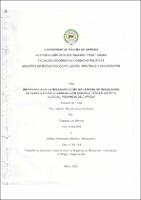Importancia de la mediación como mecanismo de resolución de conflicto en la jurisdicción agraria, tercer distrito judicial, provincia de Chiriquí.

View/
Date
2021Author
Loo Berroa, Edgardo
Sánchez Villavicencio, Edison Iluminado
Metadata
Show full item recordAbstract
Es admirable la trascendencia de la nueva cultura de paz instaurada en los
últimos 20 años, a pesar de existir una norma procedimental (Código Judicial de
1982) sobre el arbitraje, nacen como figuras autónomas en el año 1999 ella
arbitraje, la mediación y la conciliación.
Es determinante señalar que la ambigüedad que enmarca el Decreto Ley No. 5
de 1999, solo permite introducir las figuras alternas de solución de conflicto, pero
que a medida que ha pasado los años. Las mismas se han delineado con
Características muy propias y determinantes dentro de las diferentes
jurisdicciones en el ámbito de la justicia panameña. Pero a medida de su
evolución, el Decreto Ley No. 5 fue derogado por la Ley 131 del 2013,
convirtiéndose en un marco legal específicamente para regular la figura del
arbitraje.
No cabe duda, que el Decreto Ley No. 5 marco el inicio trascendental de una
nueva corriente que se ha venido desarrollando paulatinamente
, bregando de
manera exitosa y escalando en la mentalidad del panameña, como alternativa
viable para solucionar los conflictos
Cabe señalar, que en los últimos 10 años se ha visto introducir prácticamente en
Diferentes jurisdicciones las figuras de mediación comunitaria, mediación penal,
mediación familiar, mediación agraria, arbitraje comercial, arbitraje marítimo,
mediación y conciliación en materia de asuntos del consumidor. No es de
extrañar que adicional a esto se ha visto de igual manera y de forma privada las
mediaciones escolares y empresariales como una tónica positiva al
desenvolvimiento de los métodos alternos de solución de conflictos en él
acontecer de los panameños
Por consiguiente, es de relevancia consignar una investigación que conlleve él
estudio exhaustivo de los métodos alternos de solución de conflictos en materia
agraria y con énfasis en la mediación, especialmente, ante las nuevas
disposiciones emanadas del Código Agrario, la cual ubican a la mediación,
conciliación y arbitraje como mecanismos alternos para resolver los conflictos
agrarios.
De esta manera se pretende cumplir con determinados objetivos, la cuál sé
enfocan a la revisión del Código Agrario, a resaltar la importancia de la mediación
como método alterno de solución de conflictos en los asuntos agrarios y por último verificar los efectos que este mecanismo tiene ante los conflictos agrarios. The significance of the new culture of peace established in the
last 20 years, despite the existence of a procedural rule (Judicial Code of
1982) on arbitration, were born as autonomous figures in 1999.
arbitration, mediation and conciliation.
It is decisive to point out that the ambiguity that frames Decree Law No. 5
of 1999, only allows the introduction of alternative conflict resolution figures, but
that as the years have passed. They have been outlined with
Very own and determining characteristics within the different
jurisdictions in the field of Panamanian justice. But as your
evolution, Decree Law No. 5 was repealed by Law 131 of 2013,
becoming a legal framework specifically to regulate the figure of the
arbitration.
There is no doubt that Decree Law No. 5 marked the transcendental beginning of a
new trend that has been gradually developing
, struggling
successful way and climbing in the Panamanian mentality, as an alternative
feasible to resolve conflicts
It should be noted that in the last 10 years we have seen the introduction of
Different jurisdictions the figures of community mediation, criminal mediation,
family mediation, agrarian mediation, commercial arbitration, maritime arbitration,
mediation and conciliation in consumer affairs. It is not from
It is surprising that in addition to this, the
school and business mediations as a positive tone to
development of alternative conflict resolution methods in it
happenings of Panamanians
Consequently, it is relevant to record an investigation that entails
exhaustive study of alternative methods of conflict resolution in matters
agrarian and with emphasis on mediation, especially in the face of new
provisions emanating from the Agrarian Code, which place mediation,
conciliation and arbitration as alternative mechanisms to resolve conflicts
agrarians.
In this way it is intended to meet certain objectives, which I know
focus on the revision of the Agrarian Code, to highlight the importance of mediation
as an alternative method of conflict resolution in agrarian affairs and finally verify the effects that this mechanism has in agrarian conflicts.
